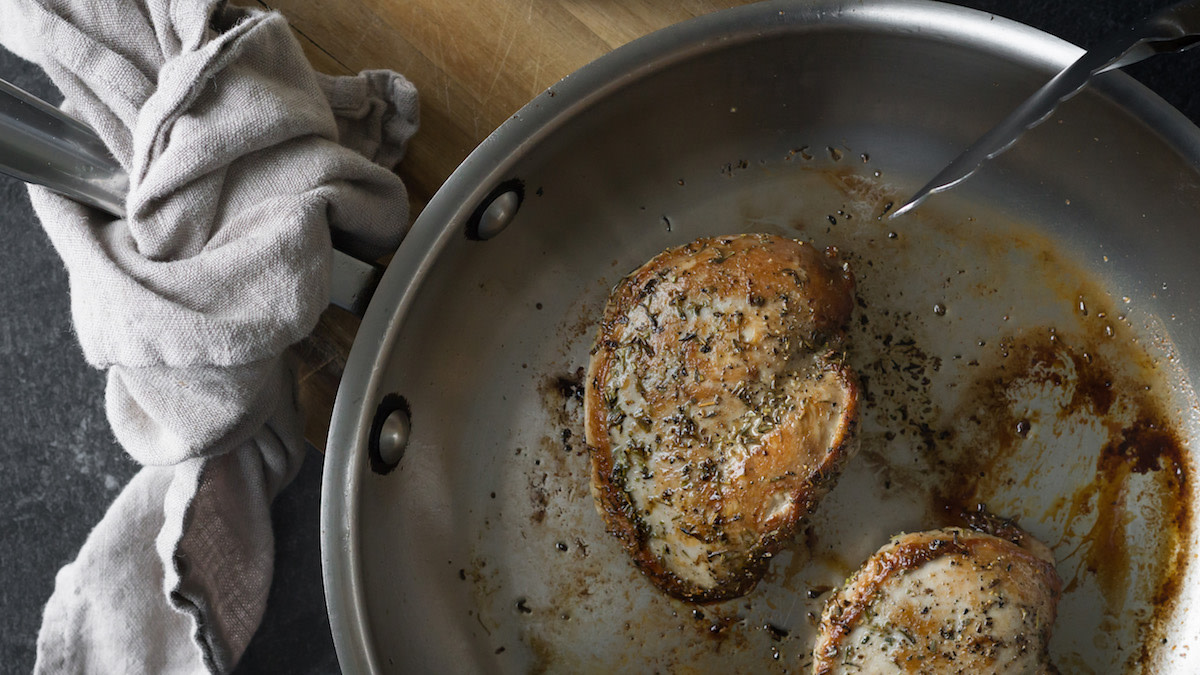
Pan roasting is one of my favorite cooking techniques. I often implement it because it yields excellent results and will work with any kind of protein. This two-step process starts with searing meat in a hot sauté pan, flipping, and immediately transferring to a hot oven.
This technique is one of the best ways to cook wild game evenly and ensure that it retains moisture. It’s ideal when preparing thick cuts, like the breast of a Canada goose. It’s also great for animals that need to reach a high internal temperature to avoid trichinosis.
When meat is seared directly over high heat, the browning reaction adds flavor and creates a beautiful golden crust on the outside. Transferring it to an oven with hot circulating air applies even heat. This technique allows you to cook the interior to the right temperature without drying it out.
A bonus is that the meat stays in the same pan you seared it in. This reserves juices and leaves behind the drippings, or “fond,” which enhances the flavor of your pan sauce.
With practice, you can get this technique down pat and learn to control the process so that the meat comes out perfect every time. Once you’re fluent in pan roasting, check out this stuffed venison backstrap recipe.
If time allows, season white meat such as pheasant, turkey, or hogs with a sprinkle of salt 24 hours before cooking. The salt acts as a dry brine and makes a noticeable difference in the juiciness of wild game. When you are ready to cook, pull the meat out of the fridge and allow it to come to room temperature. Use this time to preheat an oven. The temperature I set it at varies depending on what I’m cooking. I go as low as 300°F for meat that needs a long period of cooking time like mountain lion, hogs, and bears. For smaller cuts that cook fast like pheasant I go up to 375°F. I consider 350°F a moderate temperature for animals that fall in between like turkey and geese.
Before cooking it’s essential to pat the meat very dry with a paper towel. Then heat a large, oven-proof sauté pan over medium-high heat. Add a glug of oil or fat with a high smoking point, such as grape seed, avocado, canola, coconut, duck fat, or ghee.
When the oil is hot, use tongs to lay the meat down. Don’t overcrowd the pan, and be sure to leave space in between each piece. If you place them too close together, the meat will sweat which prevents browning. Often when the meat hits the hot pan it likes to contract and shrink, creating a dome-like effect in the center. To avoid this, I use the back of a spatula and press it down into the pan so that the surface gets full contact.
Once you place your meat down, leave it down! I know sometimes it’s hard to resist, but don’t mess with it or try to move it around until a crust has developed. You’ll know when it is ready to flip because the meat will lift freely off the pan without sticking.
After flipping, I like to add a pat of butter to the pan. Once it melts, you can tilt it to the side and use a spoon to baste the meat.
After flipping, transfer the pan to the oven. Cooking times will depend on the type of meat you’re cooking and the thickness of the cut. Use a thermometer to check the internal temperature and pull the meat out 5 to 10 degrees before it hits the target temperature because the meat will continue to cook as it rests.
While the meat rests, you can create a nice pan sauce out of the fond left over as long as you didn’t burn it. While you do so, I advise putting a pot holder on the handle of the pan. It sounds like an obvious decision to not touch a hot pan straight out of the oven, but unfortunately I have some scars to prove otherwise!





